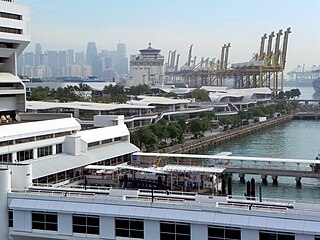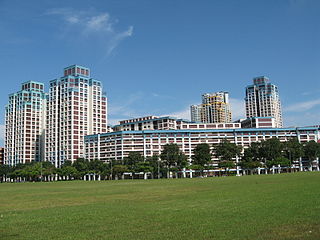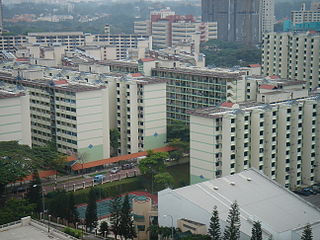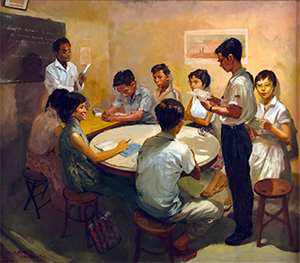Related Research Articles
Tiong Bahru is a housing estate located within the Bukit Merah Planning Area, in the Central Region of Singapore. Tiong Bahru was constructed in the 1920s by the Singapore Improvement Trust, the predecessor to the Housing Development Board and an entity of the British colonial authority providing mass public housing in Singapore and is the oldest housing estate in Singapore. The main estate consists of 30 apartment blocks with over 900 units of two to five rooms. There are also high-rise Housing and Development Board (HDB) flats and condominiums along Boon Tiong Road, Jalan Membina and Kim Tian Road which surround the main estate.

Bukit Merah, often abbreviated as Bt Merah, is a planning area and new town situated in the southernmost part of the Central Region of Singapore. The planning area borders Tanglin to the north, Queenstown to the west and the Downtown Core, Outram and Singapore River planning areas of the Central Area to the east. Bukit Merah also shares a maritime boundary with the Southern Islands planning area located beyond its southernmost point. Bukit Merah is the most populated planning area in the Central Region, and the 12th most populated planning area in the country overall, being home to more than 150,000 residents.

The Sun Yat Sen Nanyang Memorial Hall, also known as Wan Qing Yuan, and formerly as the Sun Yat Sen Villa, is a two-story colonial style villa in Balestier, Singapore. The villa is now a museum commemorating Sun Yat Sen (1866–1925), the founding father of the Republic of China who visited Singapore nine times between 1900 and 1911.
The literature of Singapore comprises a collection of literary works by Singaporeans. It is written chiefly in the country's four official languages: English, Malay, Standard Mandarin and Tamil.
This is a list of Singapore-related articles by alphabetical order. To learn quickly what Singapore is, see Outline of Singapore. Those interested in the subject can monitor changes to the pages by clicking on Related changes in the sidebar. A list of to do topics can be found here.

Goh Poh Seng was a Singaporean dramatist, novelist, doctor and poet, was born in Kuala Lumpur, British Malaya in 1936. He was educated at Victoria Institution in Kuala Lumpur, received his medical degree from University College Dublin, and practised medicine in Singapore for twenty-five years.

The Cenotaph is a war memorial located within the Esplanade Park at Connaught Drive, within the Central Area in Singapore's central business district.

Public housing in Singapore is subsidised, built and managed by the Government of Singapore. Starting in the 1930s, the country's first public housing was built by the Singapore Improvement Trust (SIT) in a similar fashion to contemporaneous British public housing projects, and housing for the resettlement of squatters was built from the late 1950s. In the 1960s, under the SIT's successor the Housing and Development Board (HDB), public housing consisting of small units with basic amenities was constructed as quickly and cheaply as possible at high densities, and was used for resettlement schemes. From the late 1960s, housing programmes focused more on quality, public housing was built in new towns, and a scheme allowing residents to own their flats was introduced. Throughout the 1970s and 1980s, more public housing options were provided for the middle class and efforts to increase community cohesion within housing estates were made. From the 1990s, the government began portraying public housing as an asset, introducing large-scale upgrading schemes and loosening regulations on the resale of public housing while additional housing programmes for the sandwich classes and elderly residents were introduced. Rising housing prices led to public housing being seen as an investment from the 2000s, and new technologies and eco-friendly features were incorporated into housing estates.

Gan Eng Seng School (GESS) is a co-educational government secondary school in Bukit Merah, Singapore. Founded in 1885 by philanthropist Gan Eng Seng, the school is the first school established by the overseas Chinese community in Singapore and is one of the oldest schools in the country.

Bukit Ho Swee is a subzone within the planning area of Bukit Merah, Singapore, as defined by the Urban Redevelopment Authority (URA). Its boundary is made up of the Alexandra Canal in the north; Kim Seng Road and Outram Road in the east; Zion Road and Jalan Bukit Ho Swee in the south; Delta Road and Lower Delta Road in the west.

Kim Seng Road is a street in Singapore that runs along the upper-easternmost portion of the Bukit Merah-Central Area border. It was named after Peranakan philanthropist, Tan Kim Seng. Today, the boundaries of Kim Seng division are: Indus Road and Alexandra Canal in the north; Jalan Bukit Ho Swee in the south; Kim Seng Road and Outram Road in the east; and Lower Delta Road in the west.

Great World MRT station is an upcoming underground Mass Rapid Transit station on the Thomson-East Coast Line at the boundary of River Valley and Singapore River planning areas, Singapore.
Bernard Lim Soon Seng is a former Singapore international footballer who played as a right wing-back for Tanjong Pagar United in the S.League.
Philippe Aw Thiam Hor is a Singapore professional football coach and former player who is former head coach of S.League club Hougang United.

The visual art of Singapore, or Singaporean art, refers to all forms of visual art in or associated with Singapore from its history to present. Its history ranges from the beginnings of ancient Singapore, possibly from the 10th century AD, to the present-day country. The emergence of modern Singaporean art, or more specifically, "the emergence of self-aware artistic expression" is often tied to the rise of art associations, art schools, and exhibitions in the 20th century, though this has since been expanded to include earlier forms of visual representation, such as from Singapore's pre-independence period.

The Equator Art Society was an artists' group founded in 1956 in Singapore, known for promoting social realist art. The Equator Art Society sought to represent the realities and struggles of the masses, depicting Singapore's working classes and the poor often through the use of portraiture painting, woodcut prints, and sculpture. Founded by artist Lim Yew Kuan, other society members and leaders included artists Lai Kui Fang, Chua Mia Tee, Ong Kim Seng and Koeh Sia Yong.
78 Moh Guan Terrace, also known as The Horse-shoe Block, is a SIT block in Tiong Bahru, Singapore. It the only block in Singapore with the unique "horse-shoe" design.
Lim Nang Seng was a Singaporean sculptor. He sculpted the Merlion statue in Merlion Park.
References
- ↑ "The art and architecture of Tiong Bahru". ura.gov.sg. Urban Redevelopment Authority . Retrieved 11 April 2022.
- 1 2 3 "Tiong Bahru Heritage Trail" (PDF). NHB. National Heritage Board . Retrieved 11 April 2022.
- 1 2 3 "Seng Poh Garden & Dancing Girl Sculpture". Roots. National Heritage Board . Retrieved 11 April 2022.
- ↑ Zacchius, Melody (15 April 2013). "An estate steeped in history". The Straits Times . Singapore.